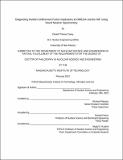Diagnosing inertial confinement fusion implosions at OMEGA and the NIF Using novel neutron spectrometry
Author(s)
Casey, Daniel Thomas
DownloadFull printable version (5.939Mb)
Other Contributors
United States. Dept. of Energy. National Ignition Facility.
Advisor
Richard Petrasso.
Terms of use
Metadata
Show full item recordAbstract
A novel neutron spectrometer, called the Magnetic Recoil Spectrometer (MRS), was designed, built, and implemented on the OMEGA laser facility and the National Ignition Facility (NIF) to measure the neutron spectra from inertial confinement fusion (ICF) implosions. Using the MRS, the down-scattered neutron (DSn) spectrum has been used to infer the areal density ([rho]R) of ICF implosions for the first time. The DSn technique is essential for diagnosing high [rho]R (>180mg/cm²) cryogenic deuterium-tritium (DT) implosions, where most other methods fail. The MRS has helped to guide the cryogenic campaign toward the highest [rho]Rs ever achieved at OMEGA. In addition, the MRS is currently being used to diagnose the DSn spectrum from cryogenic implosions at the NIF during the beginning phases of the National Ignition Campaign (NIC). MRS data have already been essential for tuning these implosions to the highest [rho]Rs ever achieved in an ICF implosion (>1 g/cm²), and thus for guiding the NIC toward the realization of thermonuclear ignition. The first measurements of the T(t,2n)⁴He (TT) neutron spectrum in DT implosions at OMEGA have also been conducted using the MRS. The TT-neutron (TTn) spectrum was measured at low reactant central-mass energies of ~23 keV. The results from these measurements indicate that the TT reaction proceeds primarily through the direct three-body reaction channel, which is in contrast to the results obtained in higher energy accelerator experiments. Measurements of the TTn and DD proton yields were also conducted and compared to the DT neutron yield in DT implosions. From these measurements, it is concluded that the DD yield is anomalously low and the TTn yield is anomalously high, relative to the DT yield. These results have been explained by a stratification of the fuel in the core of an ICF implosion.
Description
Thesis (Ph. D.)--Massachusetts Institute of Technology, Dept. of Nuclear Science and Engineering, 2012. This electronic version was submitted by the student author. The certified thesis is available in the Institute Archives and Special Collections. Cataloged from student submitted PDF version of thesis. Includes bibliographical references (p. 139-148).
Date issued
2012Department
Massachusetts Institute of Technology. Department of Nuclear Science and EngineeringPublisher
Massachusetts Institute of Technology
Keywords
Nuclear Science and Engineering., University of Rochester. Laboratory for Laser Energetics., United States. Energy. National Ignition Facility.